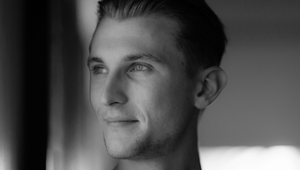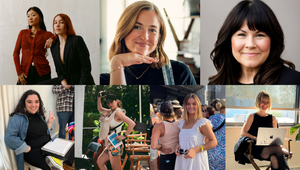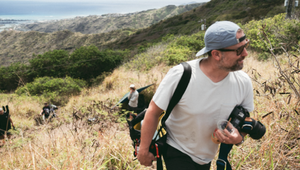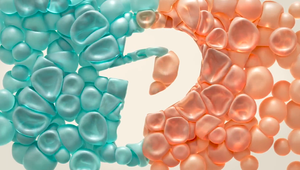
From Court to Screen: Behind The Scenes of #AllInCeltics with VAGRANTS

In the high-stakes world of sports docu-series, capturing the raw emotion and intensity of the playoffs requires meticulous craftsmanship and a collaborative spirit. This was the mission for Tyler Clinton, senior editor at VAGRANTS, and Lennon Mapes, the studio's adept colourist, as they teamed up with the creative studio Shadow Lion to bring the #AllInCeltics series to life. This all-access series delves deep into the Boston Celtics' 2024 playoff journey, offering fans an unprecedented behind-the-scenes look at one of sports' most legendary franchises.
LBB> How did the collaboration come to be?
Tyler> We got a call from our friends at Shadow Lion about an upcoming project where they needed to expand their team. They mentioned VAGRANTS having a similar style and needed editors that could provide polished rough cuts, considering the tight turn around they’d be up against.

(from left to right: Ben Stone, editor, Trevor MacKinnon, editor, Jeff Fine, director)
LBB> What were the team’s biggest challenges when adapting to Shadow Lion's post-production workflow?
Tyler> We do set up our projects differently. We make transcodes with Media Encoder or DaVinci, while Shadow Lion uses Premiere’s built in proxy workflow. While there are pros and cons to both, the Premiere proxy workflow was necessary for this in terms of speed. Turning out a 20 min episode in 10 days didn’t allow for any down time. Using Premiere’s proxies let us start organising the raw footage right away, and we could set proxies to be created overnight or during any break.
Shadow Lion also used markers with detailed description along with generated transcripts, so that quotes could be quickly searched. This increased efficiency dramatically since early interviews were used over the course of the entire series. Overall, it took a little getting used to, but was necessary for such a large team to have a single system.
Lennon> To me, these things become habits much sooner than the hierarchy of folder structure and organisation. This was my, and possibly Tyler’s biggest challenge. Imagine knowing where every book in a library lives, then one day they become jumbled and sorted in a completely different way. A new folder structure system is obviously not a bad thing, but I believe it takes the most time to get used to out of any of the technical processes we adapted to throughout the course of the project.

(From left to right: Tyler Clinton, senior editor, Lennon Mapes, assistant editor)
LBB> What unconventional approaches did you take in your colouring and editing process for this project?
Tyler> On our kickoff call, Shadow Lion asked if we’d also be able to contribute with any finishing tasks, which we were happy to provide. Lennon does a lot of our colour at Vagrants and we thought he’d be perfect for this. We walked in expecting to be able to handle colour with our standard workflow. But they immediately brought it to our attention, that we won’t be able to have a locked cut to then take a day or two to colour. Final edits would be taking place just hours before delivery, so we had to make a new plan.
Shadow Lion asked if we could make a couple of custom LUTs (Look-Up Tables) that could universally be used over the variety of cameras they shot with, but with the large variables in shooting environments and different operators, this didn’t really pan out. Lennon and I made the call that the best way to handle colour would be to focus on the interviews and colour those properly in DaVinci.
Uncoventionally, we coloured the entire interview with all camera angles instead of exporting just the clips used in the film. This quickly was a home run since interviews were recycled throughout the whole series, and meant that anything added to later episodes would already be coloured. So Lennon took the helm and grinded out any new interview they shot, followed by replacing our multicam sequences with the newly coloured version. As for the b-roll, we worked with some of our initial custom LUTs made in DaVinci, then made subtle tweaks in Premiere with Lumetri. This all took place the night before the episode was delivered.
Lennon> Adding onto the topic of colouring the interviews, I had to create a list of characteristics of each interview session and compare them on a scale of least to most important. For example, when colouring a commercial or a narrative film, the colourist would (hopefully) have the time and ability to:
1. Develop a creative look.
2. Ensure proper skin tones are represented.
3. Match shots in the same/similar environment.
4. Match shots in unrelated environments to the overall look of the film.
In this case, some sacrifices had to be made for time's sake. This meant the hierarchy of importance for image characteristics had to change and look something like this: 1. Match the background colour and exposure as closely as possible for every camera 2. Ensure proper skin tones are represented.
For look development, there was no efficient way to apply a LUT universally between DaVinci and Premiere without an extraordinary amount of time re-tweaking in Premiere. For shot matching, we were able to match different interview days as best as possible, but with slightly different camera and lighting setups each time, that made this task quite difficult.
Lastly, since we were batch colouring and replacing clips in a multicam sequence in Premiere, we had no idea what clips would be used next to each other. Sometimes A cam and B cam from day one looked great cut next to each other, as well as other clips from day one. However, putting A cam day one and C cam day three next to each other made the differences much more noticeable. This is why matching the background colour and overall exposure levels became the most important characteristic to keep consistent throughout all interviews.
LBB> What lessons from this project will you carry forward into future work?
Tyler> It's been a while since I've been on such a heavy deadline driven project. Getting reacquainted to extremely quick turnarounds helped reinvigorate what can be done when a great team works hard together. We were all joking about how we’d be able to bust out a :60 second broadcast ad in a day after this project. As Lennon put it, “Nothing scares me now”.
After developing a relationship that can only be described as a family, it was bittersweet packing up after the last episode came out. Hopefully we’ll get the opportunity to work together again, whether it be another Shadow Lion project or a VAGRANTS production.
Lennon> This experience has shown the true malleability of a professional post production team. Being able to rearrange pieces of your workflow in order of importance with regards to timeliness was a key factor to the success of this project. Without any prior knowledge of another team’s workflow, we were quickly able to adapt, thrive and learn how we could best become a key part of the team.
This transformation was not without its difficulties, and we encountered many technical challenges along the way… but editors are problem solvers, so when you throw a bunch of them in a room together you know shit will get done!
















